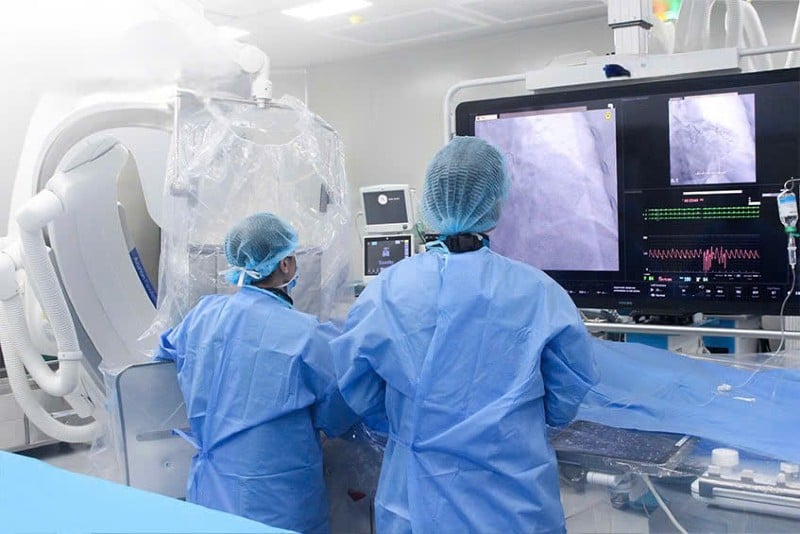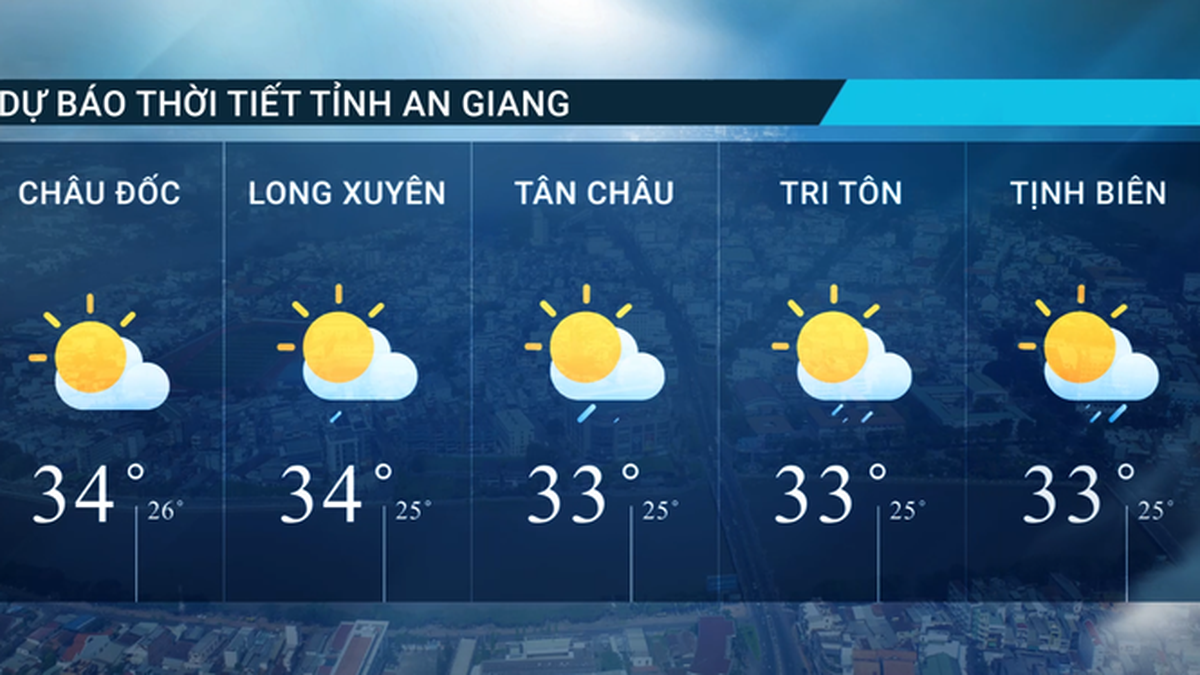Alarm bell for cardiovascular health because of tobacco
His case is a warning bell about the link between smoking and cardiovascular disease in the elderly. Before being hospitalized, Mr. B. had symptoms of dull chest pain lasting 4 days. Initially, he went to a local medical facility for examination and was prescribed medication, but his condition did not improve.
 |
| Doctors are performing surgery on the patient. |
He then went to the hospital for examination, and cardiac enzyme test results showed an abnormally high Troponin T level: 1228 ng/L (while the normal value is below 14 ng/L).
After performing an electrocardiogram and echocardiogram, he was diagnosed with non-ST elevation myocardial infarction, a form of acute coronary syndrome that occurs when one or more coronary arteries are incompletely blocked, causing significantly reduced blood flow to the heart muscle.
At the hospital, Dr. Nguyen Xuan Vinh (Interventional Cardiology Center) said that the patient had a history of high blood pressure but did not have regular check-ups, and smoked a pack of cigarettes a day for 30 years. These are two leading risk factors for myocardial infarction.
Coronary angiography results showed that all three major coronary artery branches were narrowed. In particular, the right coronary artery was completely blocked in the distal segment, with thrombosis; the anterior interventricular artery and the circumflex artery were also severely narrowed. Without timely intervention, the patient could face the risk of arrhythmia, heart failure, or sudden death.
Dr. Nguyen Van Duong, MD, said that the main culprit was damage to the distal right coronary artery. The damage to the anterior interventricular branch was also very severe and at risk of progression. Therefore, the team decided to prioritize right coronary intervention to restore blood flow to the undernourished myocardium.
The intervention was divided into two phases to limit the procedure time and minimize the impact on kidney function. In the first intervention, the doctor used a specialized catheter to aspirate the thrombus, then performed balloon angioplasty and placed two stents in the anterior interventricular artery and the distal right coronary artery.
After the procedure, Mr. B's chest pain was significantly reduced. The patient continued medical treatment and anticoagulant medication.
Four days later, he had two more stents placed in his circumflex artery. Post-intervention images showed that the stents were well deployed, with no complications, and blood flow to the heart had been re-established.
Two days later, he was discharged in stable condition, prescribed long-term medication, and instructed to quit smoking and have regular check-ups.
According to the World Health Organization (WHO), tobacco smoke is a major cause of non-communicable diseases such as cardiovascular disease, stroke and chronic obstructive pulmonary disease. Tobacco smoke contains more than 7,000 chemicals, including more than 70 carcinogens.
Substances such as nicotine, carbon monoxide and tar directly damage the endothelium of blood vessels, promoting atherosclerosis - the main cause of coronary artery stenosis and myocardial infarction.
Smoking also increases the risk of blood clots forming, which can completely block blood flow to the heart muscle, leading to a heart attack.
Dr. Nguyen Xuan Vinh recommends that people over 50 years old with risk factors such as smoking, high blood pressure, diabetes, dyslipidemia, etc. should have regular cardiovascular health screenings. If you have symptoms such as chest pain, chest tightness, pain spreading to the neck, shoulders, arms, or fainting, you should go to a medical facility immediately for timely treatment.
Mr. B.'s case is a warning to those who smoke and do not control their underlying diseases well. Lifestyle changes, especially quitting smoking, can save your life and significantly improve your quality of life.
Rare disease detected in one health check
A 71-year-old man was diagnosed with the rare disease Takayasu's arteritis after being accidentally found to have severe narrowing of multiple blood vessels during a routine health check-up.
Thanks to early detection, he received timely surgery, avoiding dangerous complications such as heart attack or stroke.
Mr. T., 71 years old, came for a general health check-up without any obvious symptoms. However, the doctor discovered an abnormal difference between the blood pressure measured in the arms and legs, a sign suggesting severe narrowing of the blood vessels.
Master, Doctor, CKII Huynh Thanh Kieu, Head of Department of Cardiology 1, Cardiovascular Center, Tam Anh General Hospital, Ho Chi Minh City, ordered specialized tests including vascular ultrasound, ABI index measurement (ankle/arm blood pressure), multi-slice CT scan (MSCT) of the carotid and coronary arteries.
The results showed that Mr. T. had severe narrowing (>90%) of all three branches of the blood vessels supplying the heart, as well as narrowing of the bilateral carotid arteries, the right vertebral artery, and the bilateral subclavian arteries. This condition is consistent with Takayasu's arteritis - a rare autoimmune disease, usually found in women under 50 years old. Mr. T.'s case is considered particularly rare.
Dr. Kieu said that Takayasu's arteritis affects the aorta and its large branches, causing inflammation, leading to narrowing or aneurysm.
If left untreated, the disease can progress to complete blockage, causing serious complications such as heart attack, stroke, or heart failure.
Mr. T's case shows the silent danger of this disease, when the damage progresses over many years without obvious symptoms.
Master, Doctor Tran Thuc Khang, Deputy Head of Cardiovascular Surgery Department, and his team decided to perform coronary artery bypass surgery to restore blood flow to the heart.
However, what was special about this surgery was that the subclavian arteries, which are usually used as grafts, were severely narrowed and could not be used. The doctors used the patient's own saphenous vein to make a new bridge, bypassing the blocked arteries.
The surgery was performed with a spontaneously beating heart, without the need for an extracorporeal circulation machine. After the surgery, Mr. T. recovered well, was extubated after only 8 hours, returned to the inpatient room after 48 hours, and resumed normal activities after 3 days. He was discharged after 4 days of intensive treatment.
Dr. Khang said that even after successful treatment, Takayasu’s arteritis can recur. Therefore, patients need to continue taking medication to control inflammation, combine a healthy diet, exercise regularly, and control associated diseases such as high blood pressure and dyslipidemia.
Doctors also recommend that patients stay away from tobacco, a factor that damages blood vessels and increases the risk of restenosis, and get all the necessary vaccinations to prevent respiratory diseases such as flu, pneumonia, and shingles.
According to Dr. Huynh Thanh Kieu, early detection of Takayasu's arteritis is a key factor in effective treatment and prevention of complications.
Patients should see a doctor immediately if they have unusual signs such as difficulty breathing, chest pain, pain in the arms and legs, dizziness, weakness in one side of the body, or speech disorders, symptoms that can be warning signs of a stroke due to narrowing of a large artery.
Old lady almost had her liver removed because of an abnormally large 3.5 cm gallstone
The 76-year-old female patient experienced a dangerous case of severe cholangitis due to many large stones in the liver and gallbladder, causing the bile duct to dilate nearly 10 times, facing the risk of having to remove her liver.
According to Dr. Vo Ngoc Bich, a specialist in Hepatobiliary - Pancreatic diseases, who directly treated the patient, gallstones measuring 3.5 cm are very rare, while gallstones over 2.5 cm are considered rare.
The ability to self-excrete such large stones is very low, and at the same time, the risk of complications is high, such as stones stuck in the gallbladder neck or common bile duct, causing obstruction of bile flow, acute or chronic cholecystitis, even gallbladder cancer and liver resection.
Two weeks before admission, the patient had symptoms of fatigue, nausea, and poor appetite. Her condition did not improve despite treatment at a local medical facility. One week later, she began to have dull pain in the right hypochondrium and vomited after eating.
3 Tesla magnetic resonance imaging (MRI) results showed that stones filled the gallbladder and left hepatic duct. The diameter of the left hepatic duct was dilated to 8 mm; the common bile duct was dilated to 21 mm (normal 1-5 mm), containing many stones, the largest of which was up to 2 cm. In particular, the gallbladder contained many mud stones with the largest stone measuring nearly 3.5 cm.
Due to the serious condition, the patient was indicated for laparoscopic cholecystectomy, common bile duct opening to remove stones, combined with cholangioscopy to crush and remove stones in the left liver. The doctor prepared a plan for open surgery to remove liver segments if the number of stones in the liver was too large or the damage was severe.
During the surgery that lasted more than 2 hours, the team noted a distended gallbladder, dissected the hepatobiliary triangle, cut the artery and cystic duct. Then, they opened the common bile duct, removed many large stones, washed away the mud in the left hepatic bile duct, placed a Kehr drain and sutured the common bile duct. The patient did not need liver resection thanks to timely intervention.
After surgery, the patient recovered well, was able to sit up, walk, and eat light food after 1 day, and was discharged after 3 days. Her health is currently stable, and she is scheduled for a follow-up visit after a week.
Intrahepatic bile duct stones are formed by the aggregation of bile components in the ducts in the liver parenchyma, unlike gallbladder stones which are usually cholesterol.
In Asia, liver stones are mainly pigment stones associated with parasitic infections, bile stasis or metabolic disorders. Patients may have no obvious symptoms, only detected during a health check or when abdominal pain, fever, jaundice appear.
Doctor Vo Ngoc Bich recommends that everyone should have regular health check-ups, especially when there are signs of digestive abnormalities.
To prevent gallstones, it is necessary to maintain food hygiene, avoid raw food to reduce the risk of parasitic infection; increase green vegetables, fruits, drink enough water; limit foods high in cholesterol, fat, fried foods, canned foods, alcohol. In addition, it is recommended to deworm every 6 months and maintain physical activity to increase bile circulation, reducing the risk of stone formation.
Source: https://baodautu.vn/tin-moi-y-te-ngay-235-phat-hien-benh-hiem-takayasu-o-nguoi-dan-ong-71-tuoi-d288863.html



































































































Comment (0)